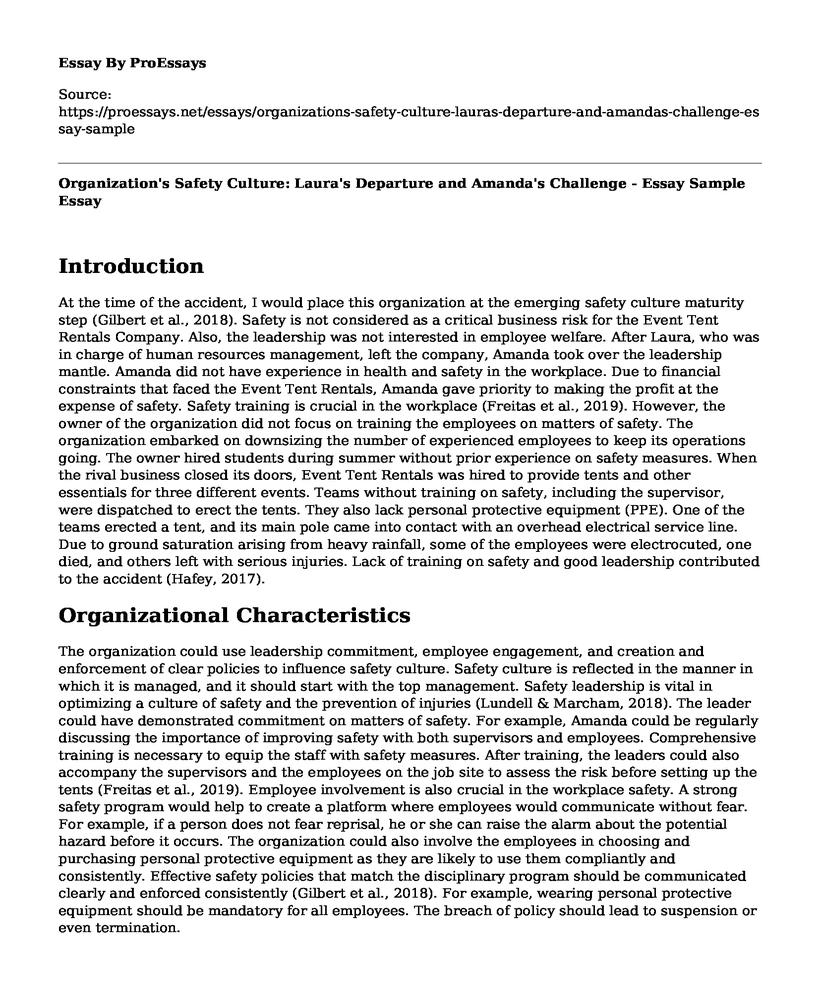Introduction
At the time of the accident, I would place this organization at the emerging safety culture maturity step (Gilbert et al., 2018). Safety is not considered as a critical business risk for the Event Tent Rentals Company. Also, the leadership was not interested in employee welfare. After Laura, who was in charge of human resources management, left the company, Amanda took over the leadership mantle. Amanda did not have experience in health and safety in the workplace. Due to financial constraints that faced the Event Tent Rentals, Amanda gave priority to making the profit at the expense of safety. Safety training is crucial in the workplace (Freitas et al., 2019). However, the owner of the organization did not focus on training the employees on matters of safety. The organization embarked on downsizing the number of experienced employees to keep its operations going. The owner hired students during summer without prior experience on safety measures. When the rival business closed its doors, Event Tent Rentals was hired to provide tents and other essentials for three different events. Teams without training on safety, including the supervisor, were dispatched to erect the tents. They also lack personal protective equipment (PPE). One of the teams erected a tent, and its main pole came into contact with an overhead electrical service line. Due to ground saturation arising from heavy rainfall, some of the employees were electrocuted, one died, and others left with serious injuries. Lack of training on safety and good leadership contributed to the accident (Hafey, 2017).
Organizational Characteristics
The organization could use leadership commitment, employee engagement, and creation and enforcement of clear policies to influence safety culture. Safety culture is reflected in the manner in which it is managed, and it should start with the top management. Safety leadership is vital in optimizing a culture of safety and the prevention of injuries (Lundell & Marcham, 2018). The leader could have demonstrated commitment on matters of safety. For example, Amanda could be regularly discussing the importance of improving safety with both supervisors and employees. Comprehensive training is necessary to equip the staff with safety measures. After training, the leaders could also accompany the supervisors and the employees on the job site to assess the risk before setting up the tents (Freitas et al., 2019). Employee involvement is also crucial in the workplace safety. A strong safety program would help to create a platform where employees would communicate without fear. For example, if a person does not fear reprisal, he or she can raise the alarm about the potential hazard before it occurs. The organization could also involve the employees in choosing and purchasing personal protective equipment as they are likely to use them compliantly and consistently. Effective safety policies that match the disciplinary program should be communicated clearly and enforced consistently (Gilbert et al., 2018). For example, wearing personal protective equipment should be mandatory for all employees. The breach of policy should lead to suspension or even termination.
Safety Culture Measurement Methods
I could use quantitative and qualitative methods of measuring improvement in safety culture at the organization (Halaj, 2017). The quantitative measure would entail checking the availability of personal protective equipment for all the employees. For example, if all the employees have PPE, it is an indication of improvement. The qualitative measure involves the use of questionnaires and interviews. All the staff, including the leaders, could be provided with questionnaires to fill. The questionnaires would have questions concerning how the individuals and leaders perceive safety, employees' involvement, and use of PPE consistently and compliantly. Face-to-face interviews would also be conducted to the individuals. For example, I would ask the employees whether they get adequate training on safety. I might expect that the organization has provided PPE for every staff. I would also anticipate that employees perceive safety as critical and make use of PPE all the time in the line of their duties. I might also expect the organization to provide adequate safety training to the employees and the supervisors (Lundell & Marcham, 2018).
References
Freitas, A. C., Silva, S. A., & Santos, C. M. (2019). Safety training transfer: The roles of coworkers, supervisors, safety professionals, and felt responsibility. Journal of occupational health psychology, 24(1), 92. https://psycnet.apa.org/doiLanding?doi=10.1037%2Focp0000125
Gilbert, C., Journe, B., Laroche, H., & Bieder, C. (2018). Safety cultures, safety models: Taking stock and moving forward. Cham, Switzerland.
Hafey, R. (2017). Lean Safety: Transforming your safety culture with lean management. CRC Press.
Halaj, M. (2017, September). How to Measure the Safety Culture of Organizations. In CBU International Conference Proceedings (Vol. 5, pp. 622-626). https://www.researchgate.net/publication/320494390_HOW_TO_MEASURE_THE_SAFETY_CULTURE_OF_ORGANIZATIONS
Lundell, M. A., & Marcham, C. L. (2018). Leadership's effect on safety culture. Professional Safety, 63(11), 36-43. https://pdfs.semanticscholar.org/ab75/269c4aaa585ac769aa30b92f4b97858b4875.pdf
Cite this page
Organization's Safety Culture: Laura's Departure and Amanda's Challenge - Essay Sample. (2023, May 16). Retrieved from https://proessays.net/essays/organizations-safety-culture-lauras-departure-and-amandas-challenge-essay-sample
If you are the original author of this essay and no longer wish to have it published on the ProEssays website, please click below to request its removal:
- Why I Want to Be a Paralegal Essay Example
- Annotated Bibliography on Bullying in the Workplace
- Impact of Collective Bargaining in the Society Essay
- Essay on Improving Teacher Induction Programs Through Supervision & Staff Development
- Bar Ethics: Conflict of Interest & More - Essay Sample
- Essay on Tata: India's Largest Company, Corporate Social Responsibility, Maintaining Competitive Advantage
- Essay Example on the Art of Being a Great Student Leader: My Journey of Motivating Others







